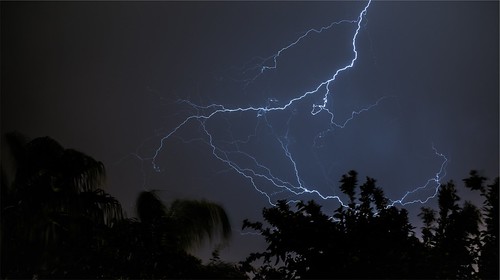Safety first for Arkansas fish producers, anglers during thunderstorm season
By Will Hehemann,UAPB School of Agriculture, Fisheries and Human Sciences
June 21, 2016
Fast Facts:
- Lightning Safety Awareness week, June 19-25
- Fisheries workers need to use extra caution
(495 words)
PINE BLUFF, Ark. – As the nation observes Lightning Safety Awareness Week June 19-25, 2016, Arkansas fish producers and anglers should keep some safety practices in mind when working in and around ponds, says Larry W. Dorman, Extension aquaculture specialist at the University of Arkansas at Pine Bluff.
“Statistics tell us that annually there are 22 million cloud-to-ground lightning strikes in the U.S.,” Dorman said. “Lightning travels incredibly fast, estimated at 1,000 feet per one-millionth second, and currents average nearly 25,000 amps with voltages in the hundreds of millions.”
Lightning, like any electrical current, follows the path of least resistance to the ground, he said. Therefore, people working around ponds need to ensure they are not a part of that path during an electrical storm.
“If you are harvesting fish in an aluminum boat, immediately motor to the pond’s levee and evacuate all workers,” Dorman said. “It is best for workers to move to a secure farm shop and wait out the storm. To ensure safety, they should never stand near electrical conductors such as electric aeration equipment, electric panel boxes, electric wells or back-up generators.”
If a secure building is not available, the inside of a vehicle offers good protection, he said. A fish loading truck can also be a safe option for shelter, but producers should remember to lift the truck’s outriggers off the ground as they could potentially offer a path for electricity between the sky and the ground.
Dorman said it is not safe to stand or lie down on a concrete pad, as the rebar inside concrete is made of common steel, which is a good conductor of electricity. People should also avoid standing under feed storage bins; though they may look like a good form of protection, they are metallic and fairly tall, making them conductors of electricity.
“If you are caught without a safe structure, crouch in a balled-up position,” he said. “Multiple individuals need to spread out and keep some distance between each other because a lightning strike can travel across the ground. People should also remember to never stand under a tree, as electricity can travel down a tree trunk.”
Dorman said fish producers should remember not to resume work activities around ponds too quickly after a storm. It is best to wait to get back to work at least 30 minutes after the last sound of thunder.
“When it comes to thunderstorms and working around water, it’s always best to be on the safe side,” he said. “Remember, the life you save may be your own.”
Pursuant to 7 CFR § 15.3, the University of Arkansas System Division of Agriculture offers all its Extension and Research programs and services (including employment) without regard to race, color, sex, national origin, religion, age, disability, marital or veteran status, genetic information, sexual preference, pregnancy or any other legally protected status, and is an equal opportunity institution.
###
Media Contact: Mary Hightower
Dir. of Communication Services
U of A Division of Agriculture
Cooperative Extension Service
(501) 671-2126
mhightower@uada.edu
Related Links
